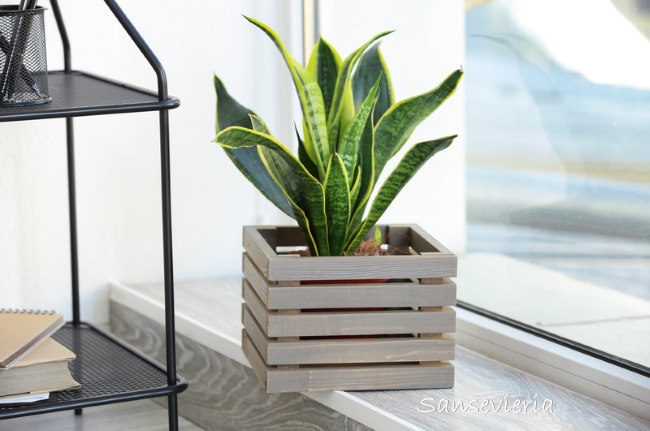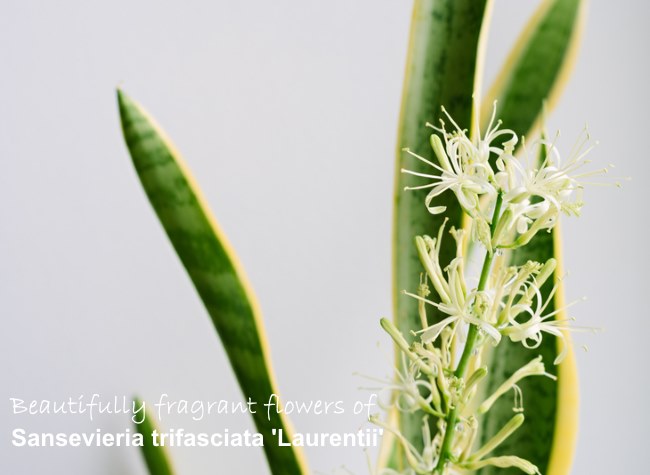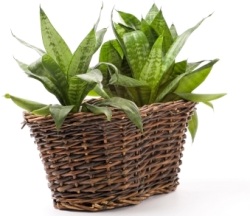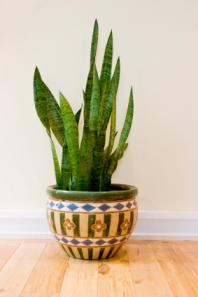Mother-in-Law's Tongue
Botanical Name: Sansevieria trifasciata
Mother-in-Law's Tongue (also known as Snake Plant) is one of the most carefree house plants you can grow. It thrives in just about any light. Prefers dry air and soil. Rarely needs repotted.
It's ideal for beginners, but seasoned gardeners also love this accent plant's dramatic, sword-shaped leaves. Slow-growing, Sansevieria will live for many years with good care.
 Plenty of bright light will keep Mother-in-Law's Tongue plant healthy. Photo © Serezniy
Plenty of bright light will keep Mother-in-Law's Tongue plant healthy. Photo © SerezniyGet to Know Your Houseplant
This succulent house plant grows stiffly upright variegated leaves, reaching about 2-ft (60 cm) tall when grown in a container. Bands of light green across each dark-green leaf give Sansevieria a decorative snakeskin pattern.
Will it bloom? Maybe. Clusters of small, white flowers sometimes grow on a tall flower stem from the base of a plant when it is a few years old. It rarely blooms indoors, and it may go years between flowering, so it's a nice surprise when it does. Those flowers are beautifully scented at night.
 Fragrant flowers may appear on plants grown in bright light. Photo ©Viktoryia Kelasyeva
Fragrant flowers may appear on plants grown in bright light. Photo ©Viktoryia KelasyevaAn evergreen perennial, this South African succulent wants warmth and sunlight year-round.
Although Mother-in-Law's Tongue is practically legendary for tolerating neglect, it responds to good care. Give it what it wants and you'll enjoy your houseplant for several years.

Mother-In-Law's Tongue Varieties
Some varieties have leaves that are edged with yellow or white. Clump-forming 'Laurentii' is a popular variety that is edged in golden yellow.
S. trifasciata 'Hahnii' is a low-growing (10 in/25 cm) variety with broader leaves. Its compact, rosette form gives it the common name Bird's Nest Sansevieria. 'Golden Hahnii' has yellow leaf margins...'Silver Hahnii' has silvery leaves marbled with dark green.
Sansevieria Problems, Solutions and Answers
Don't over-water. Any problems with growing Sansevieria are usually related to watering. Allow the top inch (2.5 cm) of soil to dry out between waterings during the growing season. In winter, water just enough to prevent the soil from drying out. Overwatering will cause root rot.
Watering Tip
Water the soil, taking care not to get water on the leaves, which will cause them to rot. If the leaves turn yellow, or get soft and mushy at their base, it's overwatered.
Keep leaves dust-free and glossy by wiping them with a damp cloth. Cleaning the leaves also helps the plant take in sunlight through photosynthesis. Need another reason to get out the dust cloth? Regular cleaning prevents pests from taking up residence.
Watch for pests. Mealybugs are attracted to succulents. Look for white, cotton-like specks clustered near the base of the leaves. Mealybugs suck plant juices, causing damage if left untreated. Spider mites are perhaps the most dreaded houseplant pest. They're so tiny, you'll probably only notice the fine webbing between leaves. Wipe off webs and spray with insecticidal soap. Isolate any infested houseplant and treat your plant right away. If your houseplant is badly damaged, get rid of it.
Repot in spring, only when plants get crowded and need dividing. Don't plant it too deep -- keep the the plant at the same depth it was before to prevent crown rot. Those roots are shallow, so a shallow pot will do. Tall varieties will become top heavy, so use a wide, heavy container to prevent toppling.
Mother-in-Law's Tongue Care Tips

Origin: South Africa
Height: Up to 2 ft (60 cm); some varieties are low-growing
Light: Bright light to full sun. Will tolerate low light.
Water: Keep soil lightly moist in the growing season. In winter, water just enough to prevent the soil from drying out. Allow the top 1-inch (2.5 cm) to dry out before watering again. Take care not to water the center of the rosette of leaves because they'll rot easily if kept wet.
Humidity: Average room (around 40% relative humidity). Mother-in-law's tongue will tolerate dry air, but keep it away from air vents or drafts.
Temperature: Average room temperatures 65-75°F/18-24°C. Don't expose Mother-in-Law's Tongue to temps below 60°F/16°C; this South African succulent doesn't like the cold.
Soil: Cactus potting mix is ideal because it is fast-draining
Fertilizer: Feed once a month spring through fall with fertilizer specially made for succulent plants.
Propagation: Division or leaf cuttings. Sansevieria is easy to divide because it has shallow roots. Simply turn the pot on its side and pull out the entire plant. Use a sharp knife to cut through the thick roots and pot each clump separately. To propagate Mother-in-Law's Tongue by leaf cuttings, cut leaf into 2-inch (5 cm) pieces and place them right side up (the way they were growing) in moist perlite or cactus potting mix; they will grow plantlets around the base of the cuttings.


